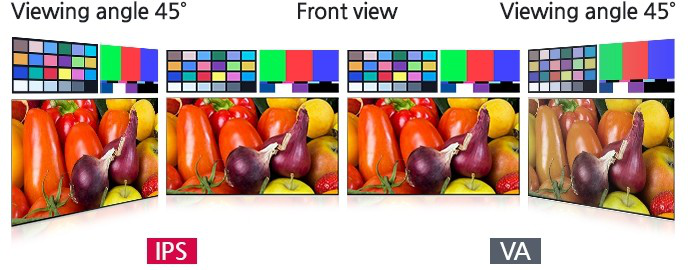


VA Display vs. IPS Display in 4K HDR TVs: What You Need to Know
by Stephen on April 6, 2017


Stephan Jukic – April 6, 2017
Recently, we covered the pros, cons and differences in general between three types of modern 4K HDR TV panel. These were OLED TVs, LCD/LED TVs and, the newest additions to the television landscape, QLED TVs. In covering those technologies, we briefly alluded to VA and IPS displays in 4K TVs for the QLED and LCD variations of TV display as it exists today. Now we’re going to give you breakdown of what these two terms mean and how they’ll affect your 4K TV experience. It’s also worth noting here that VA and IPS display panel technologies have nothing to do with OLED 4K TVs, those are an entirely different matter.
IPS and VA are two types of LCD TV panel technologies that completely dominate today’s LED-backlit 4K TV market. All LCD TVs sold by the major US and overseas brands that you’re going to find from any retailer right now come built either with VA display panel technology or IPS display panels. This also applies to today’s QLED TVs from Samsung since, all marketing jargon and a few color deliver improvements aside, QLEDs are still basically LCD/LED-backlit TVs (at least for now). So obviously, with this much market presence, VA and IPS are important, and knowing which means what will have an impact on what sort of 4K TV you buy, because both VA and IPS come with their own specific pros and cons, as we’re going to cover now.

Differentiating VA and IPS
VA stands for vertical alignment in a display panel and IPS stands for In-Plane Switching in a display panel. While both panel types do the same basic thing, which is filter LED backlighting through their pixel designs and color filters to create an image on your 4K TV, they each perform this fundamental task in their own highly particular ways. This of course heavily affects how both technologies perform.
To summarize, all LCD TVs, 4K or not, basically operate by using tiny liquid crystal structures inside the RGB (Red, Green Blue) color packets which make up each pixel to form different colored images through reactions and position changes in these crystals when they’re charged with electricity. Depending on how said LCD crystals are being charged, their positions will also change and either block light or allow it to pass through them to certain degrees.

As a result, both IPS and VA panels create their specific levels of brightness, black depth and color delivery. However, as we said, each performs the above process in its own way and with very different performance results between the two. In the case of IPS display panels, their LCD crystals are horizontally aligned by design and when they’re charged, they rotate in ways that either let light flow through or block it. With VA panels, crystal alignment is vertical (as the name suggests) and these crystals only move horizontally when charged to allow light through.
However, because VA display crystals are vertically aligned when closed and thus more narrowly positioned, they block out light far more effectively if needed. In contrast, IPS crystals tend to allow more backlight light bleed due to their constant horizontal position. Another effect of these different alignment patterns is that, while VA panel crystals are far better at blocking light due to their vertical closed positioning, this same design causes viewing angles in VA TVs to be much narrower.

There are other differences between the two TVs, as we’ll cover in a second but in basic terms, IPS TV display panels deliver much broader viewing angles at the cost of weak black levels and contrast ratios. VA 4K TV panels deliver far superior blacks and contrast, which are both extremely important for high picture quality, while IPS panels are weak on contrast and black level but manage superb viewing angles. Let’s look at these and other details a bit more now.
Black Level & Uniformity
Absolute black levels are without a doubt better in Vertical Alignment panel 4K TVs. This is something we’ve noted across the board in all cases of VA design in any 4K TV from any brand when compared to IPS models from the same or any other brand. Your typical 2016 or 2017 VA panel display can deliver black levels of between 0.025 and 0.015 nitswhile their IPS counterparts from even the best manufacturers like Vizio, Sony and LG manage between 0.075 and 0.090 nits. This is a major difference and it’s particularly notable during high contrast scenes or when watching a TV in dimly lit rooms. It’s probably the single biggest negative to IPS display panels and because contrast and deep rich black levels are so important to high quality visuals, the weak blacks of IPS displays can negatively affect color perception and realism. They can also affect HDR quality since even in HDR IPS TVs, black levels remain poor.

It should however ne noted that some 4K IPS TVs come with local dimming technology. A particularly good example of this are several of Vizio’s 2016 and 2017 HDR LCD 4K TVs. Local dimming, which actually shuts off some of the LED backlights in an LCD TV’s backlight array can thus allow an IPS TV to deliver much deeper black levels when the feature is activated. This applies especially to full-array LED backlit IPS 4K TVs like Vizio’s P-Series 55 inch model.
Black uniformity in IPS 4K TVs also suffers heavily due to the design of IPS pixel arrays. Because their pixels bleed more light in general, small variations in light bleed or LED backlight brightness are much more easily visible, creating cloudy effects when a display is set to deliver complete blackness.
Our Verdict: VA panel technology is an absolute winner at delivering superior black levels and black uniformity.
Contrast Ratios
The answer to which display panel type wins at this comparison should be obvious. Given the far superior black levels of Vertical Alignment technology, contrast ratios in VA panel TVs are dramatically superior to those of IPS models unless high quality local dimming is taken into consideration. The difference is enormous too. While a typical VA 4K TV model can manage native contrast ratios of 3500:1 at the very least, and in many cases deliver contrast ratios of 6000:1 or better, we have yet to see an IPS 4K TV handle contrast ratios that go beyond 1400:1. For most IPS 4K TVs such as the majority of LG’s LCD models, contrast is actually even weaker than this, in some cases sitting at 850:1 or even lower. This is to be expected of IPS but it’s not a good spec for quality picture performance.

VA contrast vs IPS contrast on right in a darkened room
Our Verdict: VA is the winner at contrast by a huge margin.
Color performance
When it comes to both SDR 4K TVs and HDR models with wide color gamut and 10-bit color, the raw color volume differences between IPS models and VA models are almost null. In other words, all HDR wide color specs being equal, the two different display panel types perform about the same at delivering high dynamic range color, 10-bit color for 1.07 billion color values and overall color saturation. LG’s Super UHD 4K HDR TVs such as the UH9500 and UH8500are two particularly notable IPS TV models with superb color performance despite their weak contrast ratios and black levels compared to a typical mid-range VA HDR TV with the same HDR color specs.
However, black levels and contrast do create a visual perception of more vibrant colors due to how the human eye perceives contrasts. Thus, a VA TV with deeper, richer blacks can look like its delivering sharper, richer colors in content simply because the onscreen dark tones contrast so much more sharply with colorful objects in the same piece of content. This is something that viewers should keep in mind and a reason why black levels and high contrast are considered so important for a more realistic and vibrant level of picture quality.

Our Verdict: IPS and VA technically tie here based on review examinations we’ve done and actual raw color volume coverage comparisons. However, in terms of human visual perception, the higher contrast and richer blacks of VA will possibly make a viewer perceive higher color quality.
Other Display Characteristics and Motion Handling
So where do IPS 4K TVs really beat their VA counterparts? Well, two important factors stand out. First and foremost, IPS –due to its horizontal pixel alignment—delivers far better viewning angles than VA display. An average VA 4K TV display will lose a significant amount of its color accuracy and contrast quality at angles of more than 20 to 25 degrees from dead center, while an IPS TV can often continue to deliver excellent display quality even when viewed from well over 50 degrees off center. This means that if you have a big living room and some of your viewing areas are way off to the side of where your TV is going to be sitting, VA will mess up the quality of the viewing experience, while IPS will work as an excellent alternative.

Secondly, IPS TVs tend to consume less power than their VA cousins due to their tendency toward lower peak brightness levels. This does of course mean that your TV can’t push out the bright highlights as well as some VA rivals but if you’re worried about saving money in the long term with your light bill, IPS gives you a bit of an edge.
It’s worth noting here that motion handling in 4K TVs is not noticeably affected by whether your TV comes with IPS or VA panel technology. In our experience, TVs with great motion handling can come in IPS versions and VA versions while performing equally at managing motion blur, judder and other things like motion interpolation. A TV that’s bad at motion control won’t be bad at it because it’s either IPS or VA in other words.
Bottom Line
Some would argue that neither IPS or VA display types are inherently superior to each other and while there is some validity to this claim due to the fact that both have uses in which one panel would be much more ideal than the other, we do think that VA is the overall better choice for most people who don’t have issues with accommodating wide viewing angles in their living room or den. Assuming you don’t need to view your 4K TV from well off center, a VA display simply delivers better performance at three of the most important display specs there are: Black level, contrast and black uniformity.
Story by 4k.com